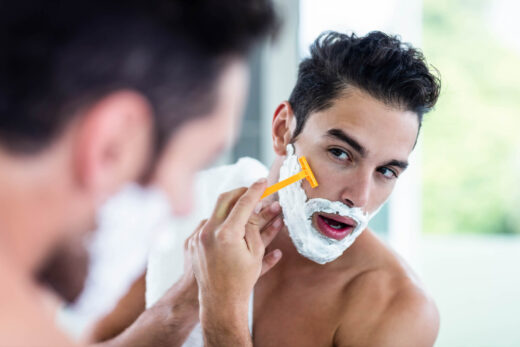Most men don’t think twice about shaving in the morning and heading straight out into the day. But what if you’re planning to spend time in the sun? Is it safe to expose freshly shaved skin to UV rays, or could this habit be silently harming your skin? The short answer: yes, shaving before sun exposure can be harmful, especially if you’re not taking the right precautions.
In this article, we’ll explore why sun exposure right after shaving can be problematic, how to soothe irritation, and what products you should use to protect your skin. Whether you’re someone with sensitive skin or you shave daily as part of your grooming routine, understanding the relationship between shaving and sun exposure can help you prevent redness, irritation, and long-term damage.

Why Is Sun Exposure After Shaving Harmful?
Shaving is more than just hair removal, it’s a mild form of exfoliation. When you shave, especially with a razor, you’re not only removing hair but also scraping off the topmost layer of dead skin cells. This leaves the skin beneath fresh, vulnerable, and more sensitive than usual.
This freshly shaved skin is:
- Thinner than usual
- More exposed to environmental aggressors
- More likely to absorb UV radiation
This sensitivity can lead to increased risk of sunburn, redness, and inflammation. In some cases, repeated exposure to the sun on freshly shaved skin can accelerate the aging process or contribute to hyperpigmentation, especially for individuals with darker skin tones.
Why Does Shaving Make Your Skin More Sensitive to the Sun?
Post-shave skin is stripped of some of its natural oils and protective barrier, which normally help shield you from irritants. This includes UV rays. When this barrier is compromised, the risk of oxidative damage increases, even with short-term exposure.
Shaving can also result in microtears or abrasions, especially if done hastily or with a dull blade. These invisible nicks make it easier for sunlight to penetrate deeper layers of the skin, potentially leading to more pronounced redness or irritation.
If you’ve ever experienced a burning sensation or flare-up after stepping into the sun post-shave, you’ve already felt the consequences of this vulnerability.
What Happens to the Skin After Shaving?
Understanding how your skin reacts to shaving can help you take better care of it. Here’s what typically happens post-shave:
- Skin Becomes Inflamed: The mechanical action of shaving causes friction, which can lead to mild redness and irritation.
- Pores Are Opened: The warm water used during shaving opens up the pores, leaving skin more susceptible to dirt, bacteria, and UV rays.
- Protective Oils Are Lost: Shaving removes the skin’s surface lipids, which are crucial in maintaining moisture and defending against environmental damage.
This cascade of reactions makes the skin particularly delicate in the hours following a shave, especially if you plan to spend time outdoors.
How to Reduce Redness After Shaving
Redness after shaving is common, especially in sensitive skin types. If you’re planning to be outside in the sun after your grooming routine, you’ll want to minimize irritation as much as possible. Here are a few proven ways to soothe redness:
- Apply a cooling balm or aftershave with aloe vera or witch hazel. These ingredients are known for their anti-inflammatory and soothing effects.
- Avoid alcohol-based aftershaves. While they may feel refreshed initially, they tend to dry out the skin and worsen irritation.
- Use a cold compress. Applying a clean, cold towel to the area for a few minutes can calm inflamed skin.
- Opt for fragrance-free products. Fragrances can irritate already sensitized skin.
- Hydrate properly. Moisturize with a lightweight, non-comedogenic lotion that includes ingredients like hyaluronic acid, panthenol, or niacinamide.
If redness persists for more than a few hours, or if bumps begin to form, you might be dealing with razor burn or folliculitis, which require more targeted care.
How to Protect the Skin After Shaving
Protection is the most important part of your skincare regimen if you’re shaving and heading out into the sun. Here’s how you can shield your skin effectively:
1. Use Broad-Spectrum Sunscreen (SPF 30 or Higher)
Apply a generous amount of broad-spectrum sunscreen 15 to 30 minutes before stepping outside. This shields your skin from both UVA and UVB rays. Pay special attention to commonly shaved areas like the face, neck, or scalp (for bald men).
2. Reapply Sunscreen Often
If you’re spending more than two hours outdoors or sweating heavily or swimming, reapply sunscreen. Shaved skin can be more absorbent and may lose sunscreen protection faster.
3. Wear Protective Accessories
A wide-brimmed hat, UV-protection sunglasses, or moisture-wicking neck gaiter can provide an extra layer of protection and reduce direct sun contact.
4. Moisturize Regularly
Follow your shave with a fragrance-free moisturizer that supports your skin barrier and locks in hydration. This helps counteract the drying effects of both the sun and the shave itself.
Best Products to Use After Shaving
The right products can make a major difference in post-shave skin health especially before sun exposure. Here’s what dermatologists and skincare experts generally recommend:
- Aftershave Balm with Aloe Vera or Chamomile: Calms redness and cools the skin naturally.
- SPF-Infused Moisturizer: Offers hydration and sun protection in one.
- Non-Greasy Sunscreen (SPF 50 preferred for the face): Especially important for oily or acne-prone skin.
- Post-Shave Serum with Niacinamide: This ingredient reduces inflammation and supports skin barrier repair.
- Witch Hazel Toner (Alcohol-Free): Naturally astringent and calming, without over-drying the skin.
If you’re someone who spends a lot of time outdoors whether for work or fitness, consider re-evaluating your shaving schedule. Shaving the night before rather than in the morning can reduce cumulative irritation.
Is It Safe to Shave After Sun Exposure?
Interestingly, shaving after sun exposure carries its own set of risks. When you spend time in the sun, especially if you’ve gotten a mild sunburn, your skin becomes more fragile, dry, and reactive. Running a razor over this damaged skin can lead to:
- Peeling and flaking
- Increased redness or even bleeding
- Razor bumps and irritation
It’s advisable to wait at least 12 to 24 hours after intense sun exposure before shaving again. If shaving is unavoidable, use an electric trimmer instead of a blade, and follow up with cooling and restorative skincare.
Timing, Technique, and Sun Care Matter
The bottom line? If you’re shaving and immediately stepping out into the sun, you’re putting your skin at risk even if you don’t feel the effects right away. Post-shave skin is delicate, and skipping sunscreen or the right aftercare can lead to long-term damage, from premature aging to persistent irritation.
Taking a few extra minutes to apply proper skincare, especially SPF, can go a long way in preserving not only your appearance but also your skin health.
Where Skin Health and Precision Care Meet

If you experience persistent irritation, hyperpigmentation, or shaving-related skin issues that don’t resolve with over-the-counter products, it may be time to consult a professional. At Erdem Hospital in Istanbul, skin specialists and dermatologists provide personalized treatment plans for men facing chronic post-shave sensitivity, razor bumps, or sun-induced inflammation. With over 37 years of multidisciplinary expertise, Erdem Hospital blends medical precision with a holistic approach to men’s skincare. Whether you’re dealing with acne-prone skin or recovering from years of sun exposure, their tailored care can help restore your skin’s balance and vitality groomed for confidence, protected for life.